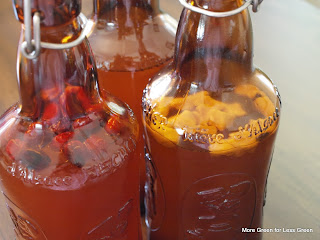The first year we started our square foot garden, I poured through every page of the Southern Exposure Seed Exchange catalogue, which specializes in heirloom and organic varieties that thrive in the Mid Atlantic region. As I read, I discovered something called a ground cherry that I never heard of before. The variety called Cossack Pineapple sounded especially delicious. How tantalizing is this?
1/2" diameter berries have a delicious flavor reminiscent of pineapple. Bite-sized berries are so tasty that they may never make it into the kitchen, especially if you have children. Excellent for preserves, hot dessert toppings, salads or mock pineapple yogurt. Plants are short (12"-18") but with bushy spreading lateral branches which choke out weeds. Fruits ripen to a pineapple yellow.
Everyone describes the flavor differently. My best description is a mix of chocolate and pineapple.
So, what are these tiny treasures? Ground cherries are native American variety of husk tomato and look like a tiny tomatillo while they are growing.
 |
| Tomatillo |
 |
| Ground Cherry |
Young tomatillos are on the top. Full-size cossacks are on the bottom. The tomatillo plant and fruit will grow to be much larger than the cossack as the season progresses. The tomatillo fruit remains green and often becomes sticky under the husk; the husk of the cossack will dry and turn brown and the fruit will fall to the ground.
Ground cherries are a nightshade and should only be eaten when the husk has dried from green to brown and the fruit falls to the ground. However, if you are feeling impatient, it is ok to give the plant a gentle shake to encourage the brown pods to fall to the ground.
 |
| Green and on the plant = not ready |
 |
| Brown and on the ground = ready |
Harvesting these little yummies is great fun for 2.5 year-old V who can gather them on his own and even pop few in his mouth straight from the garden since the husk keeps the fruit clean enough to eat right away. When they actually make it inside the house, it is fun to rinse and husk them.
Normally we just snack on these raw. But, I've also made them into jam and mixed them into chocolate frosting. The jam was yummy, though made a tiny yield. The frosting was a bust in that the chocolate overwhelmed the cossack flavor.
Because ground cherries are a native species, they grow very easily. The seeds we started indoors flopped, but the ones we direct sowed did wonderfully. Over the years, they have self-sowed and survived our various transgressions like forgetting to water or fertilize.
 |
| Our front garden is having a very good tomato, tomatillo, ground cherry year (along with some radishes to help with pests). The ground cherry plants are in the front row, left side. |
So, what do you think? Will you give ground cherries a try?
Labels: Food, Gardening


























